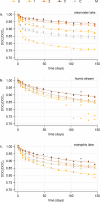Hydrophilic Species Are the Most Biodegradable Components of Freshwater Dissolved Organic Matter
- PMID: 37646447
- PMCID: PMC10501193
- DOI: 10.1021/acs.est.3c02175
Hydrophilic Species Are the Most Biodegradable Components of Freshwater Dissolved Organic Matter
Abstract
Aquatic dissolved organic matter (DOM) is a crucial component of the global carbon cycle, and the extent to which DOM escapes mineralization is important for the transport of organic carbon from the continents to the ocean. DOM persistence strongly depends on its molecular properties, but little is known about which specific properties cause the continuum in reactivity among different dissolved molecules. We investigated how DOM fractions, separated according to their hydrophobicity, differ in biodegradability across three different inland water systems. We found a strong negative relationship between hydrophobicity and biodegradability, consistent for the three systems. The most hydrophilic fraction was poorly recovered by solid-phase extraction (SPE) (3-28% DOC recovery) and was thus selectively missed by mass spectrometry analysis during SPE. The change in DOM composition after incubation was very low according to SPE-ESI (electrospray ionization)-mass spectrometry (14% change, while replicates had 11% change), revealing that this method is sub-optimal to assess DOM biodegradability, regardless of fraction hydrophobicity. Our results demonstrate that SPE-ESI mass spectrometry does not detect the most hydrophilic and most biodegradable species. Hence, they question our current understanding of the relationships between DOM biodegradability and its molecular composition, which is built on the use of this method.
Keywords: biodegradability; dissolved organic matter; electrospray ionization; freshwater; mass spectrometry.
Conflict of interest statement
The authors declare no competing financial interest.
Figures




References
-
- Cole J. J.; Prairie Y. T.; Caraco N. F.; McDowell W. H.; Tranvik L. J.; Striegl R. G.; Duarte C. M.; Kortelainen P.; Downing J. A.; Middelburg J. J.; Melack J. Plumbing the Global Carbon Cycle: Integrating Inland Waters into the Terrestrial Carbon Budget. Ecosystems 2007, 10, 172–185. 10.1007/s10021-006-9013-8. - DOI
-
- Sobek S.; Algesten G.; Bergström A.-K.; Jansson M.; Tranvik L. J. The catchment and climate regulation of pCO2 in boreal lakes. Global Change Biol. 2003, 9, 630–641. 10.1046/j.1365-2486.2003.00619.x. - DOI
Publication types
MeSH terms
Substances
LinkOut - more resources
Full Text Sources

